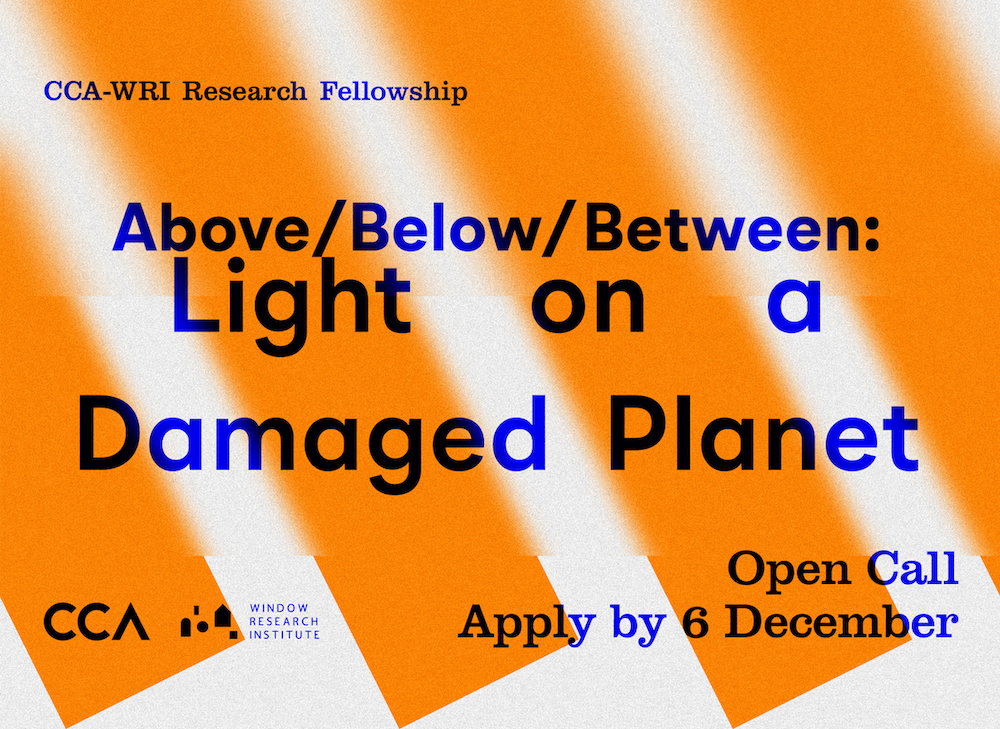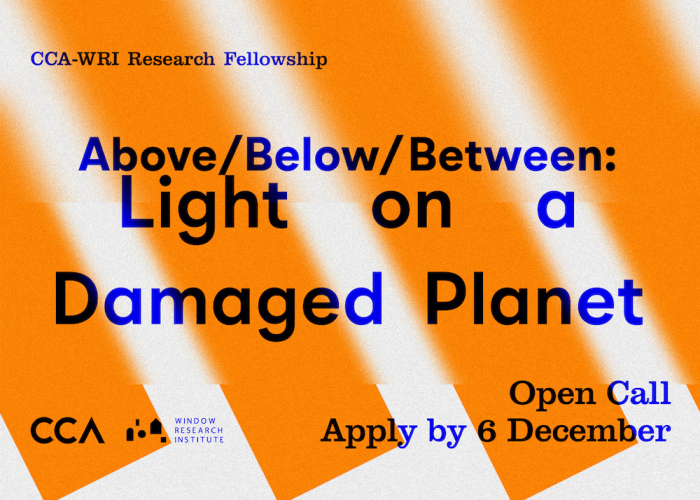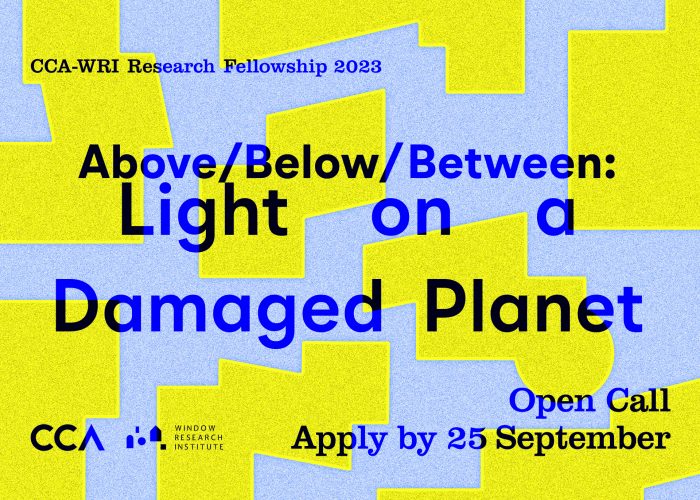This fellowship program, launched jointly with the Canadian Centre for Architecture (CCA), is open to accomplished professionals who hold a doctoral degree or have substantial work experience and a commitment to publishing, exhibiting, and/or professional practice.
The program offers a residency at the CCA for one to three months between July and October, during which fellows will address a research theme that explores the relationships between current societal issues and architecture based on the CCA collection. Each fellow will have a private office and receive monthly stipends and additional financial support for travel expenses.
We are now seeking three fellows for our 2022 program, “Above/Below/Between: Light on a Damaged Planet.” Applications are now available on the CCA application portal until December 6, 2021.
CCA-WRI Research Fellowship 2022
Above/Below/Between: Light on a Damaged Planet
We are solar societies. Depending on our location, the Earth’s rotation and its position relative to the sun determine the length of our day. Architecture continues to shape, reorient, and capture the light emitted by the sun to allow for conditions that can sustain human communities. Conversely, the absence of the sun signals the need for a form of shelter that mediates environmental conditions, often of declining temperature, and can minimize apertures to retain heat and human-made forms of light. Windows in particular are focal points for light and can lead to a network of ecological, social, and cultural considerations. At the broadest scale, architecture is determined by its position in relation to planetary cycles, with the sun allowing for the flourishing of human life.
For planet Earth this position was made particularly urgent in the 1970s, when it became apparent that chlorofluorocarbons (CFCs) were damaging the ozone layer. The “ozone hole” became a worldwide phenomenon and environmental threat, as well as a planetary-scale aperture for the damage wrought by chemical pollution. In the almost forty years that have passed since the detrimental effects of radiation on the planet due to the depletion of ozone were first discovered, the “hole” above Antarctica has almost entirely healed thanks to the international control and elimination of CFCs. In turn, it is carbon dioxide that has taken up the position of the dominant atmospheric threat.
Light under these conditions is no longer an uncomplicated factor in the provision of hygiene in the built environment. Apertures in particular amplify the role light can play in negotiating the built environment in relation to epidemiological concerns, new labour patterns, and the need for alternative forms of energy, among other issues. This emergent ecological reality is creating new practices, designs, and other social and material manifestations of architectural design that are above, below, and between; atmospheric, underground, and attentive to increasingly damaged landscapes all around us. Whether through increased average temperatures, more prevalent drought patterns, or sea level rise, light on this damaged planet is materially responsive to our human-impacted ecosystem. Apertures condense and make palpable this source of light and the need to question its root causes.
The CCA-WRI Research Fellowship seeks to understand architecture’s varied relationships to the changing material constitution of the light spectrum. We welcome applications that address the following topics, as well as those that take the theme in new directions:
• The relationships between natural resources and the built environment
• New understandings of “sustainability” that include regrowth
• Architectural responses to global warming that privilege heating, cooling, and the management of light
• Historically and geographically specific typologies, from telescopes to factory floors, reliant on natural light
• Landscape projects that respond to precise and immediate forms of environmental damage and pollution
• Future-oriented understandings of design in the Anthropocene
• New relationships between humans and their surrounding ecosystems
• New relationships between non-humans and their surrounding ecosystems
• Interrogations of the material and political parameters of “green building”
• Solar radiation as an architectural material
• Social patterns in the built environment that privilege the use of underground spaces
Fellow
| Name | Casper Laing Ebbensgaard |
|---|---|
| Affiliation | University of East Anglia |
| Title | Geographies of dangerous attachments: the vertical axis of illumination |
|
|
|
| Name | Alina Nazmeeva |
| Affiliation | Massachusetts Institute of Technology |
| Title | Made of Sunshine: Urban Commons and Real Estate, Montreal, Canada |
|
|
|
| Name | Jessica Vaughn |
| Affiliation | Temple University |
| Title | Working Skill Sets |
About the Partnership
The CCA operates in the spaces between architectural culture at large and academic discourse through exhibitions, publications, public events, and research programs. As an international research institution, it is concerned not only with building new knowledge but also with making that knowledge productive. To do this, it applies architectural perspectives to topics beyond their usual disciplinary scope and methods from other fields to traditionally architectural subjects. It aims to adopt new ways of investigating that combine cultures and perspectives emerging from architectural practice, curatorial and publishing practice, and academic study.
For over a decade, the WRI has implemented research programs focused on windows and openings. Windows––which play multifaceted roles in lighting, ventilation, viewing, security, and energy conservation––serve as intersections for various technologies and constitute one of the most fundamental elements that characterize architecture. As the contact point between the outside and inside, windows relate closely to not only architecture but to surrounding climates and people’s lifestyles. With our view of windows through a multifaceted lens—as a reflection of our society, culture, and technology—we seek to understand architecture in a fresh light to explore its role in society.
In this partnership, we aim to establish a cross-institutional fellowship program that tackles urgent public issues by combining the CCA’s comprehensive insight, collection, and research system with the WRI’s unique expertise.
Canadian Centre for Architecture
The Canadian Centre for Architecture (CCA) is an international research institution and museum premised on the belief that architecture is a public concern. We produce exhibitions and publications, develop and share our collection as a resource, advance research, offer public programs, and host a range of other activities driven by a curiosity about how architecture shapes—and might reshape—contemporary life. We invite collaborators and the wider public to engage with our activities, giving new relevance to architectural thinking in light of current disciplinary and cultural issues.
cca.qc.ca
Window Research Institute
The Window Research Institute (WRI) advances and implements research and cultural programs focused on windows. For over a decade, we have explored the role of architecture in society through our uniquely cultivated perspective. We conduct research, provide grants, and present our findings through publications, exhibitions, and lectures. Reaching beyond architecture, the Institute collaborates with a range of prominent institutions and individuals at home and abroad to develop multifaceted discussions.
madoken.jp/en
───────────────────────
Media Contacts
Julia Albani
International Press and Public Relations
Canadian Centre for Architecture
+351 911 191 898
jalbani@cca.qc.ca
Marie Sasago
Program Officer
Window Research Institute
1-1, Kanda Izumi-cho
Chiyoda-ku, Tokyo, Japan 101-0024
info@wri.or.jp
CCA-WRI Research Fellowship 2023
Window Research Institute


